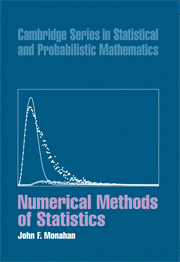Book contents
- Frontmatter
- Contents
- Preface
- 1 Algorithms and Computers
- 2 Computer Arithmetic
- 3 Matrices and Linear Equations
- 4 More Methods for Solving Linear Equations
- 5 Regression Computations
- 6 Eigenproblems
- 7 Functions: Interpolation, Smoothing, and Approximation
- 8 Introduction to Optimization and Nonlinear Equations
- 9 Maximum Likelihood and Nonlinear Regression
- 10 Numerical Integration and Monte Carlo Methods
- 11 Generating Random Variables from Other Distributions
- 12 Statistical Methods for Integration and Monte Carlo
- 13 Markov Chain Monte Carlo Methods
- 14 Sorting and Fast Algorithms
- Table of Programs and Demonstrations
- Author Index
- Subject Index
9 - Maximum Likelihood and Nonlinear Regression
Published online by Cambridge University Press: 21 March 2011
- Frontmatter
- Contents
- Preface
- 1 Algorithms and Computers
- 2 Computer Arithmetic
- 3 Matrices and Linear Equations
- 4 More Methods for Solving Linear Equations
- 5 Regression Computations
- 6 Eigenproblems
- 7 Functions: Interpolation, Smoothing, and Approximation
- 8 Introduction to Optimization and Nonlinear Equations
- 9 Maximum Likelihood and Nonlinear Regression
- 10 Numerical Integration and Monte Carlo Methods
- 11 Generating Random Variables from Other Distributions
- 12 Statistical Methods for Integration and Monte Carlo
- 13 Markov Chain Monte Carlo Methods
- 14 Sorting and Fast Algorithms
- Table of Programs and Demonstrations
- Author Index
- Subject Index
Summary
Introduction
Maximum likelihood is generally regarded as the best all-purpose approach for statistical analysis. Outside of the most common statistical procedures, when the “optimal” or “usual” method is unknown, most statisticians follow the principle of maximum likelihood for parameter estimation and statistical hypothesis tests. Bayesian statistical methods also rely heavily on maximum likelihood. The main reason for this reliance is that following the principle of maximum likelihood usually leads to very reasonable and effective estimators and tests. From a theoretical viewpoint, under very mild conditions, maximum likelihood estimators (MLEs) are consistent, asymptotically unbiased, and efficient. Moreover, MLEs are invariant under reparameterizations or transformations: the MLE of a function of the parameter is the function of the MLE. From a practical viewpoint, the estimates and test statistics can be constructed without a great deal of analysis, and large-sample standard errors can be computed. Overall, experience has shown that maximum likelihood works well most of the time.
The biggest computational challenge comes from the naive expectation that any statistical problem can be solved if the maximum of some function is found. Instead of relying solely on the unconstrained optimization methods presented in Chapter 8 to meet this unrealistic expectation, the nature of the likelihood function can be exploited in ways that are more effective for computing MLEs. Since the exploitable properties of likelihood functions follow from the large-sample theory, this chapter will begin with a summary of the consistency and asymptotic normality properties of MLEs.
- Type
- Chapter
- Information
- Numerical Methods of Statistics , pp. 199 - 234Publisher: Cambridge University PressPrint publication year: 2001



